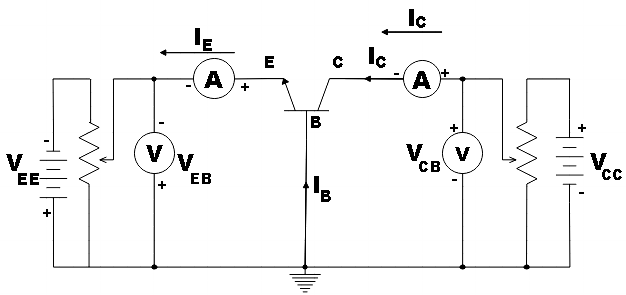
Draw circuit diagram of common base configuration.
Answer
444k+ views
Hint: Here we need to know about different configurations of a transistor and one of them is the CB i.e. the common base mode. We will consider an n-p-n transistor and we will draw the circuit diagram for that. So let’s draw the circuit diagram.
Complete step by step answer:
In case of CB mode the base terminal is common to both input and output. We need to measure the input and output voltages and currents. The diagram for the CB mode of an n-p-n transistor is given below.

The emitter- base junction is forward biased and the collector base junction is reverse biased. The ammeters and the voltmeters are connected in the circuit with correct polarities. Here the input voltage is${{V}_{EB}}$ , the input current is ${{I}_{E}}$ and the output voltage is ${{V}_{CB}}$, the output current is ${{I}_{C}}$ . The respective ammeters and voltmeters are connected to measure the values of these quantities. Also we have used two potential dividers in the input and output sides to change the values of the input and output parameters.
Additional information:
Besides this CB mode transistors are also operated in two different modes. They are Common emitter (CE) and common collector (CC) modes. In CE mode the emitter is common to both the input and output circuits and in CC mode collector is common to both the input and output circuits.
Note:
The circuit diagram needs to be drawn minutely as it involves many components. We need to forward bias the EB junction and reverse bias the CB junction. Also we need to connect the ammeters and voltmeters with correct polarities to get the readings.
Complete step by step answer:
In case of CB mode the base terminal is common to both input and output. We need to measure the input and output voltages and currents. The diagram for the CB mode of an n-p-n transistor is given below.

The emitter- base junction is forward biased and the collector base junction is reverse biased. The ammeters and the voltmeters are connected in the circuit with correct polarities. Here the input voltage is${{V}_{EB}}$ , the input current is ${{I}_{E}}$ and the output voltage is ${{V}_{CB}}$, the output current is ${{I}_{C}}$ . The respective ammeters and voltmeters are connected to measure the values of these quantities. Also we have used two potential dividers in the input and output sides to change the values of the input and output parameters.
Additional information:
Besides this CB mode transistors are also operated in two different modes. They are Common emitter (CE) and common collector (CC) modes. In CE mode the emitter is common to both the input and output circuits and in CC mode collector is common to both the input and output circuits.
Note:
The circuit diagram needs to be drawn minutely as it involves many components. We need to forward bias the EB junction and reverse bias the CB junction. Also we need to connect the ammeters and voltmeters with correct polarities to get the readings.
Recently Updated Pages
Using the following information to help you answer class 12 chemistry CBSE

Basicity of sulphurous acid and sulphuric acid are

Master Class 12 Economics: Engaging Questions & Answers for Success

Master Class 12 Maths: Engaging Questions & Answers for Success

Master Class 12 Biology: Engaging Questions & Answers for Success

Master Class 12 Physics: Engaging Questions & Answers for Success

Trending doubts
What is the Full Form of PVC, PET, HDPE, LDPE, PP and PS ?

Figure shows a conducting loop ABCDA placed in a uniform class 12 physics CBSE

Explain with a neat labelled diagram the TS of mammalian class 12 biology CBSE

The first general election of Lok Sabha was held in class 12 social science CBSE

How do you convert from joules to electron volts class 12 physics CBSE

The term ecosystem was coined by a EP Odum b AG Tansley class 12 biology CBSE




